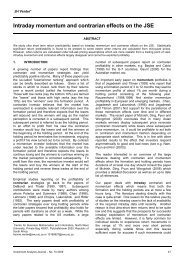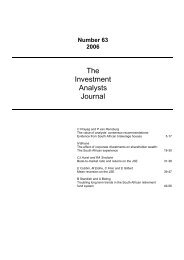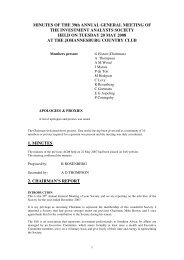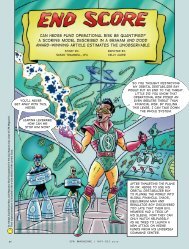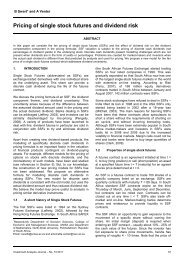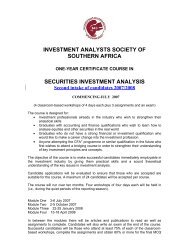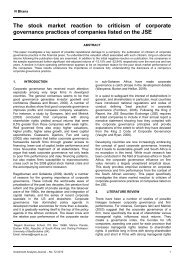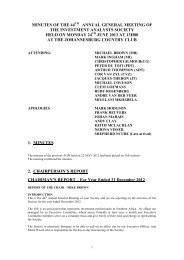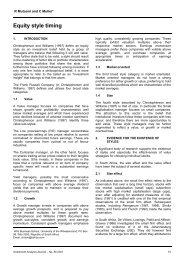Accounting is Broken - Investment Analysts Journal
Accounting is Broken - Investment Analysts Journal
Accounting is Broken - Investment Analysts Journal
You also want an ePaper? Increase the reach of your titles
YUMPU automatically turns print PDFs into web optimized ePapers that Google loves.
Stern Stewart & Co.<br />
Accountants deduct<br />
taxes that a company has<br />
not paid and pro b a b l y<br />
will never pay.<br />
The accountants defend<br />
th<strong>is</strong> nonsensical practice<br />
by jumping in bed with<br />
the bankers and pulling<br />
up the sheets.<br />
In their concern for<br />
being occasionally<br />
w rong about deadbeat<br />
companies the accountants<br />
have chosen to be<br />
always wrong about the<br />
vast majority of businesses<br />
that prosper as<br />
going concerns.<br />
To d<strong>is</strong>card the bear<strong>is</strong>h<br />
perspective of a lender<br />
and adopt the generally<br />
m o re ebullient vantage<br />
point of a shareholder <strong>is</strong><br />
in theory a straightforw<br />
a rd pro p o s i t i o n .<br />
The accountants refute that policy aim and dimin<strong>is</strong>h the relevance of re p o rted results by<br />
ignoring the taxes a company actually pays. Instead, they concoct a tax expense figure that<br />
<strong>is</strong> typically much higher than what’s been paid. They compute the tax a company would<br />
owe on t h e i r definition of income, and they deduct that hypothetical “income tax pro v i s i o n ”<br />
as an earnings levy. If a company’s taxable income <strong>is</strong> $100 and its accounting book income<br />
<strong>is</strong> $150, the tax actually paid at a 40% tax rate <strong>is</strong> $40, but the accountants will subtract 40%<br />
of $150, or $60 instead. By th<strong>is</strong> bizarre contrivance accountants deduct taxes that a company<br />
has not paid and probably will never pay, for as long as a firm remains in business it<br />
will most likely continue to generate tax deferrals through the acqu<strong>is</strong>ition of new assets.<br />
The diff e rence between the fictitious book tax prov<strong>is</strong>ion and the firm ’s actual tax bill <strong>is</strong> accumulated<br />
and buried in a balance sheet liability account called the deferred tax re s e rve. That<br />
re s e rve tends to grow larger over time as more and more taxes are deferred. GE, for<br />
instance, has a stupendous deferred tax re s e rve. On its 2001 year-end balance sheet the<br />
re s e rve was $9.13 billion and it was $8.69 billion at the end of 2000. The $440 million<br />
i n c rease <strong>is</strong> an indication of how much the accountants overstated GE’s tax and understated<br />
its profit in the 2001 year. The $9 billion ending balance <strong>is</strong> a measure of the cumulative<br />
e rror accountants have made in measuring GE’s re c u rring cash flow from its operations.<br />
The accountants defend th<strong>is</strong> nonsensical practice by jumping in bed with the bankers and<br />
pulling up the sheets. Like pinstriped lenders they concentrate on the downside of corporate<br />
perf o rmance. They ask, what if a company fails to prosper and no longer generates tax<br />
d e f e rrals? They fear the situation will reverse. They worry that the company may end up<br />
having to repay its deferred taxes. They worry most of all about bankru p t c y, for that<br />
empowers tax authorities to file a lien senior even to the most senior lenders to recover taxes<br />
p reviously deferred. To be utterly conservative, and to calm the nerves of angst-ridden<br />
c reditors, accountants feel justified charging companies in advance for taxes that they will<br />
only pay in dire circ u m s t a n c e s . 1 3<br />
In their concern for being occasionally wrong about deadbeat companies the accountants<br />
have chosen to be always wrong about the vast majority of businesses that prosper as going<br />
c o n c e rns. The fact that almost every company in the stock market trades for a value well<br />
in excess of its liquidation value <strong>is</strong> prima facie evidence that the accountants have made a<br />
systematically wrong choice. Shareholders are not generally interested in worrying about<br />
shrinking and failing. They value companies principally by the cash flow they expect fro m<br />
them as active businesses. They need and want information about that.<br />
To d<strong>is</strong>card the bear<strong>is</strong>h perspective of a lender and adopt the generally more ebullient vantage<br />
point of a shareholder <strong>is</strong> in theory a straightforw a rd proposition. Accountants should<br />
strike from profit the taxes a company has paid instead of some hypothetical tax pro v i s i o n . 1 4<br />
That done, the profit that <strong>is</strong> now being buried in the deferred income tax re s e rve will be<br />
flushed onto the NOPAT income statement and make its way into the firm ’s equity capital<br />
via retained earnings. EVA can then be computed via those rev<strong>is</strong>ed figure s . 1 5<br />
1 3<br />
When a company goes bankrupt it usually has lost so much of its going concern value that surrendering the deferred tax re s e rv e<br />
<strong>is</strong> likely to be a moot <strong>is</strong>sue for the shareholders. GE for instance now trades for a market value that <strong>is</strong> some $300 billion more than<br />
its book value. If it ever comes to liquidating the company and repaying the deferred tax re s e rve most of GE’s shareholders will<br />
a l ready have committed suicide. Only the bankers and other creditors who would fight over the remains of the carcass need get<br />
involved in that level of granularity.<br />
1 4<br />
To measure NOPAT the tax bill should also be grossed up for the additional taxes that would have been paid had interest expense<br />
not sheltered the operating profit from being fully taxed. The benefit that a company realizes from deducting interest and not paying<br />
those taxes already appears elsewhere in the EVA calculation. It <strong>is</strong> in the cost of capital, for the after-tax cost of borro w i n g<br />
money <strong>is</strong> used to compute it.<br />
1 5<br />
The year-to-year amount of taxes deferred can be quite volatile as it <strong>is</strong> geared to investment spending and other fluctuating factors.<br />
Consequently policy makers should consider an alternative approach that smoothes the measurement of EVA. The idea <strong>is</strong><br />
to recognize the benefit of deferring taxes not as a flow through on the income statement, but rather as a balance sheet re d u c t i o n<br />
in the stock of capital subject to the capital charge. The approach entails accepting the income tax prov<strong>is</strong>ion (after backing out the<br />
tax benefit of debt) as the charge to NOPAT, but then eliminating the balance sheet deferred tax re s e rve from capital by pre s e n t-<br />
ing it as a contra asset.<br />
15




